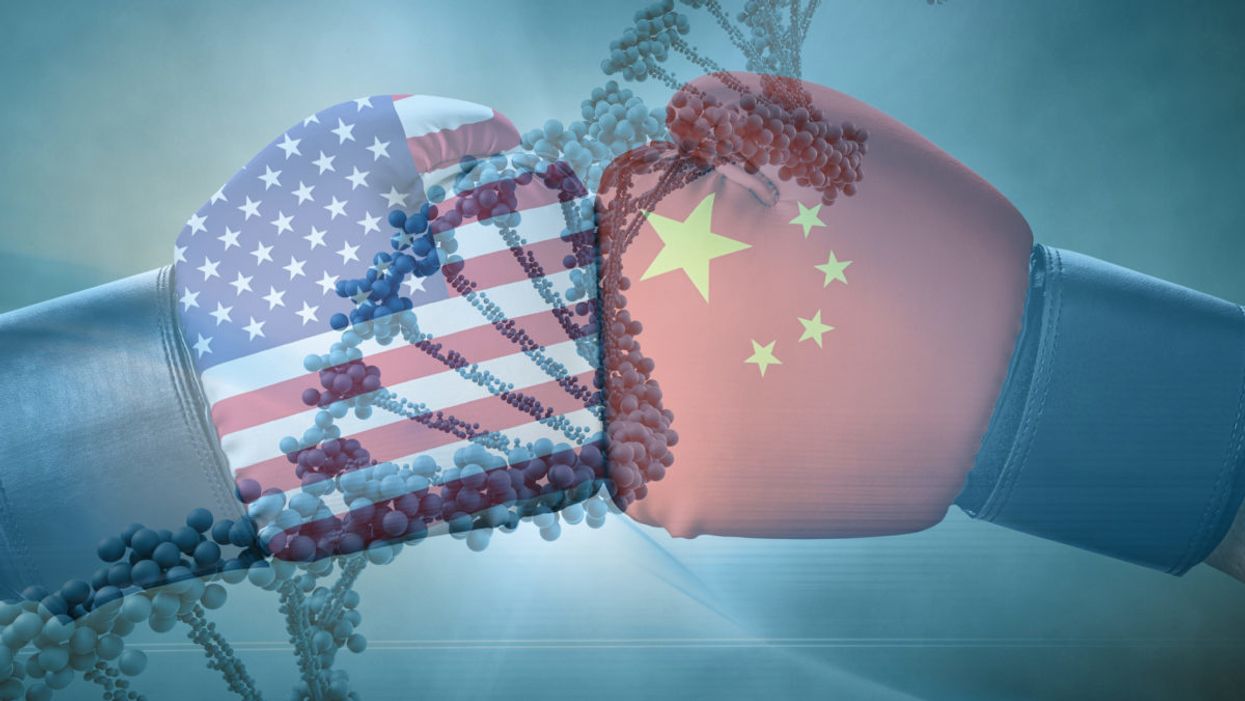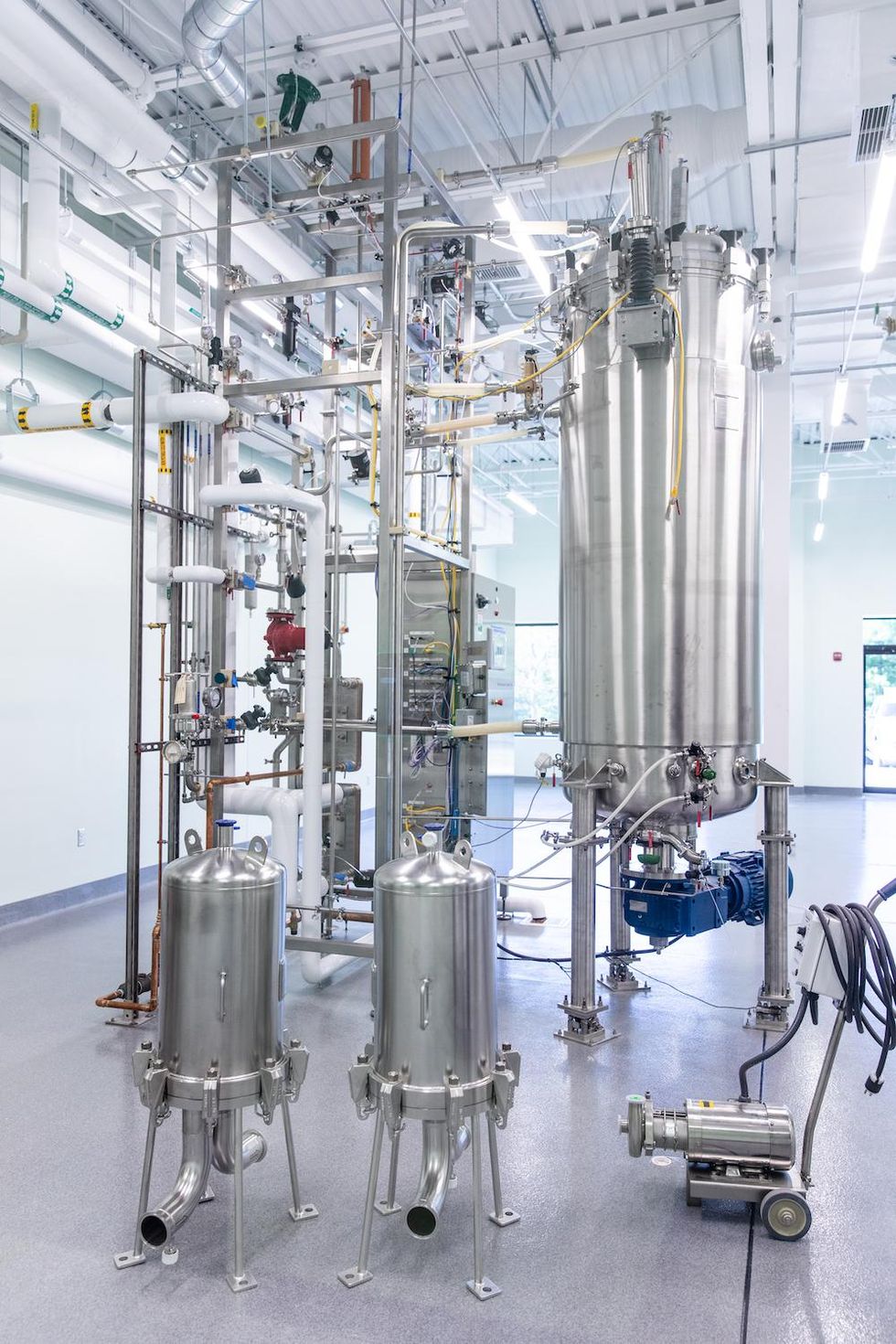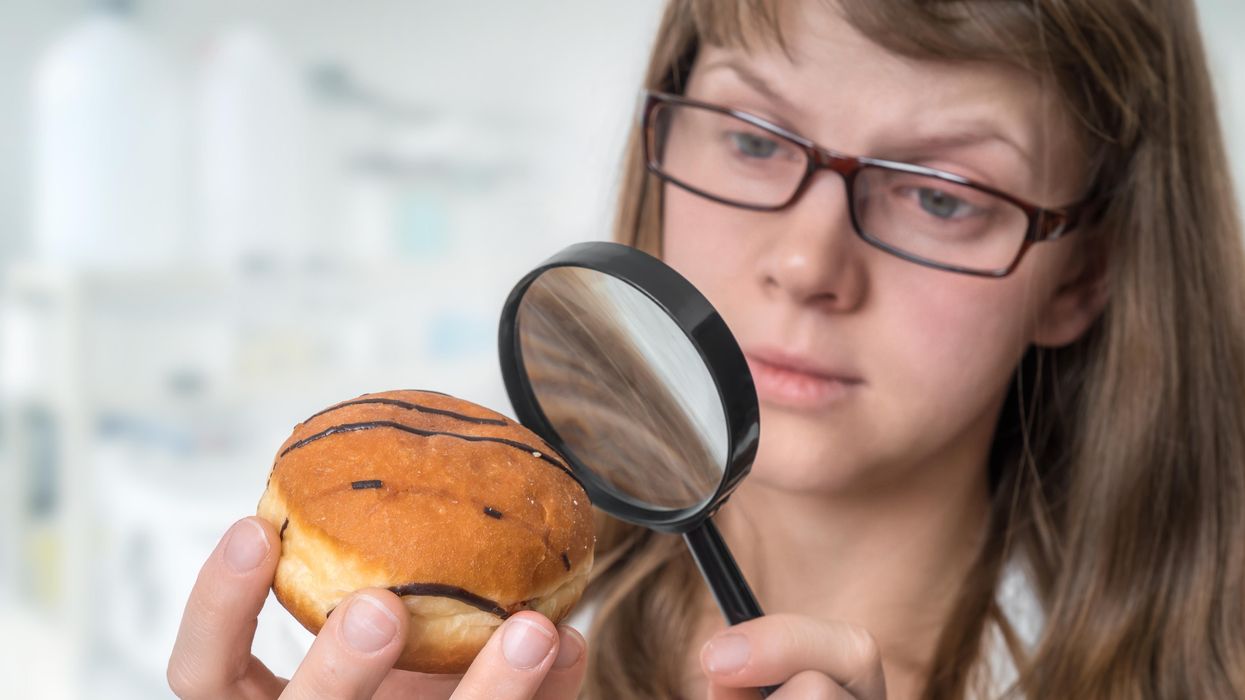China vs. the West: Who Will Lead the Way in Embryo Editing Research?

The U.S. metaphorically boxing with China over biomedical research.
Junjiu Huang and his team performed a miracle. A few miracles, actually. The researchers at Sun Yat-sen University in Guangzhou, China used the precise new DNA editing tool called CRISPR-CAS9 to edit a human embryo, replacing a single base. In doing so, they edited out beta-thalassemia, a blood disorder that reduces the production of hemoglobin, which can result in pale skin, fatigue, higher risk of blood clots, and other symptoms.
The race is on, and it's one everyone is going to try to win.
Huang's group, which did not respond to an email requesting comment for this story, injected 86 embryos and observed them for 48 hours. After that period -- a time long enough for CRISPR to split the DNA, other molecules to replace the base, and the embryos to grow to eight cells -- they tested 54 of the 71 that survived. Of those, only a few had the replacement base, according to a report of the study published in Protein & Cell. The experiment stopped there as the embryos, which had been acquired from local fertility clinics, were non-viable and not implanted.
But procreation was not the point. Far from it, in fact. The point was to demonstrate that it could be done, that in some far off (or not so far off) future, doctors could use CRISPR to eliminate diseases like Tay-Sachs, Huntington's, and cystic fibrosis that are caused by genetic mutations. Going a step further, perhaps they could eventually even tailor embryos that will develop into adults with specific traits like height and IQ.
Experts agree that we are far from that point, years if not decades away from leveraging CRISPR to cure diseases and decades if not centuries from being able to build designer babies. In that frame, Huang's achievement is just a small step, a blip on the timeline of human achievement. But seen in another light, it's yet another sign that we need to start talking about DNA modification now, establishing protocols, procedures, and plans that guide the subject before we get so far down the road that momentum is impossible to stop.
"The Chinese generally don't have the religious objections to embryo research that have held back research in the West."
It's essential to do so now because the idea of DNA modification -- a realization that humanity can control its evolution -- is compelling and attractive. Imagine a world where doctors and scientists could get rid of disease before it begins or ensure a baby would arrive with an Einstein-level IQ. That's intriguing, and also terrifying. What are the rules? How do we know when to stop? What guides the process? And how can we prevent mistakes or unwanted mutations? To borrow from another famous quotation, with great power comes great responsibility.
These aren't questions for Huang and the Chinese scientific community alone. A team from Oregon recently edited viable human embryos, eliminating a mutation that can lead to heart failure while preventing any unintended consequences. Just as importantly, every embryo they edited produced the intended genetic changes, a vital step since a partial success rate, known as mosaicism, could have devastating consequences to a future child.
In London at the Francis Crick Institute, researcher Kathy Niakan used CRISPR-CAS9 to "turn off" a gene that produces the protein OCT4. Without the protein, the fertilized egg could not produce a blastocyst, which is a key structure in early mammalian development that gives rise to an embryo and placenta. The recent study wasn't designed to go further, but the use of CRISPR was important. "One way to find out what a gene does in the developing embryo is to see what happens when it isn't working," said Dr. Niakan, who was the first scientist in the world to be granted regulatory approval to edit the genes of a human embryo for research. "Now that we have demonstrated an efficient way of doing this, we hope that other scientists will use it to find out the roles of other genes. If we knew the key genes that embryos need to develop successfully, we could improve IVF treatments and understand some causes of pregnancy failure. It may take many years to achieve such an understanding. Our study is just the first step."
The point is, CRISPR is here and it's not going anywhere. Scientists will continue to use it to learn about how humans develop. Yet different rules regarding CRISPR and embryo research in countries around the world will impact who gets there first. "I've heard the U.S.-China gene editing research parallel paths as Sputnik 2.0," said Kevin Doxzen, Science Communications Specialist at the University of California, Berkeley's Innovative Genomics Institute. The race is on, and it's one everyone is going to try to win.
Based on number of researchers and ease of regulations, the Chinese are the favorites to advance the science the furthest, the fastest.
Based on number of researchers and ease of regulations, the Chinese are the favorites to advance the science the furthest, the fastest. "The Chinese generally don't have the religious (predominantly Christian) or moral objections to embryo research that have held back research in the West," said Dr. Julian Savulescu, the Uehiro Professor of Practical Ethics and Director of the Oxford Martin Programme on Collective Responsibility for Infectious Disease at the University of Oxford. "This kind of research should be done, with the right sort of ethical oversight. The concern over China leading the way is that institutional oversight mechanisms are probably not as developed as in the West but so far, there is no evidence of breaches in standards of research ethics around the published research."
Or, put another way by bioethicist Dr. Arthur Caplan, founding director of NYU Langone Health's Division of Medical Ethics: "The Chinese, because they don't care and don't have moral reservations about embryo work, are doing what they want." This lack of aversion to working with embryos manifests itself in a couple of ways. The absence of moral qualms is one. Funding is another. Huang's study, and others like it, receive funding from the government. His, for example, was supported by two grants from the National Basic Research Program and three from the National Natural Science Foundation of China.
The U.S., on the other hand, bans any federal funding for research using human embryos. A law passed in 1996 states that federal dollars can't be used for: "research in which a human embryo or embryos are destroyed, discarded, or knowingly subjected to risk of injury or death greater than that allowed for research on fetuses." This restriction can shift incentives as many private institutions or commercial enterprises may have financial motivations or other goals beyond furthering basic research for the sake of general knowledge.
Embryo gene modification recently performed in the U.K. would merit 15 years in prison in Australia.
The embryo research ban is even more strict elsewhere. The Oviedo Convention, enacted in 1997, effectively prohibits germline engineering in members of the European Union. "In Italy, you can't destroy an embryo for any reason," said Alessandro Bertero, a postdoctoral fellow at the University of Washington's Department of Pathology who used to study in Italy. "It's illegal, and you'll go to jail." Later, Bertero was one of the researchers who worked with Dr. Niakan in London, an investigation that was allowed by the UK's Human Fertilisation and Embryology Authority. (In Australia, Niakan and her colleagues would face 15 years in jail due to the 2002 Prohibition of Human Cloning Act, which prohibits altering the genomes of embryonic cells.)
Despite the moral and legal reservations in the Western world, every person I spoke with for this story believed that better, more advanced studies and learning is happening in the U.S. and Europe. "The best studies in my opinion are from the labs in California and Oregon," Bertero said. "The quality of the work [in the Chinese study] – not being critical, but to be scientifically critical -- was just quick and dirty. It was, 'Let's just show that we have done it and get it out.' That doesn't mean that the quality of the work was good."
"If the Chinese or someone else starts beating our brains out, we're not going to want to stand by idly and not do these things."
How long that remains the case, however, is an open question. A significant number of groups in China are working on germline editing in human embryos. The concern is that the Chinese will emerge as a leader sooner rather than later because they can do research with embryos more easily than their Western counterparts.
For Caplan, the NYU professor, the embryo ban in the U.S. isn't based on science; it's rooted in something else. "It's 96 percent political," he said, laughing. "It has basically ground to a halt because no one wants to see repercussions take place if federal funding is involved. The NIH isn't involved. And they won't be."
What, in his mind, would get Americans to start realizing the benefits that embryo research would provide? "The perception that other countries were moving quickly to get the advantages of CRISPR and other gene modification techniques, finding more industrial and more medical purposes," he said. "If the Chinese or someone else starts beating our brains out, we're not going to want to stand by idly and not do these things."
Doing so would involve difficult conversations about the role of embryos in research. But these are philosophical questions that need to be approached at some point. From a U.S. perspective, doing so sooner while the American scientists still hold the technological and informational edge, is vital. Ignoring the issue doesn't make it go away.
Experts think a few changes should be made. The ban on federal funding should be lifted. Scientists and regulators should push for things like allowing federal funds to be used for the creation of new embryos for research purposes and the use of spare IVF embryos for research when the embryo would not be implanted into a woman. (Privately funded scientists can proceed in states that encourage embryonic stem cell research, like New York, New Jersey, and California, but not in restrictive ones like Louisiana and South Dakota, which prohibit creating or destroying embryos for research.) Policymakers could ban reproductive gene editing for now but look at it again after a certain period. A highly anticipated report issued earlier this year from an international guidance committee left the door open to eventual clinical trials with edited embryos. As of now, however, Congress will not allow the Food and Drug Administration to consider such trials. This is the future and it's the scientific community's responsibility to develop the ethical framework now.
"The US and Europe have the technological history and capacity to lead this research and should do so, ethically. We ought to be revising our laws and ethical guidelines to facilitate this kind of research," Professor Savulescu said. "But the challenge is to think constructively and ethically about this new technology, and to be leaders, not followers."
The Friday Five: Sugar could help catch cancer early
In this week's Friday Five, catching cancer early could depend on sugar, how to boost memory in a flash, a tiny sandwich cake could help the heart, and meet the top banana in the fight against Covid.
The Friday Five covers five stories in research that you may have missed this week. There are plenty of controversies and troubling ethical issues in science – and we get into many of them in our online magazine – but this news roundup focuses on scientific creativity and progress to give you a therapeutic dose of inspiration headed into the weekend.
Listen on Apple | Listen on Spotify | Listen on Stitcher | Listen on Amazon | Listen on Google
Here are the promising studies covered in this week's Friday Five:
- Catching cancer early could depend on sugar
- How to boost memory in a flash
- This is your brain on books
- A tiny sandwich cake could help the heart
- Meet the top banana for fighting Covid variants
A surprising weapon in the fight against food poisoning
Phages, which are harmless viruses that destroy specific bacteria, are becoming useful tools to protect our food supply.
Every year, one in seven people in America comes down with a foodborne illness, typically caused by a bacterial pathogen, including E.Coli, listeria, salmonella, or campylobacter. That adds up to 48 million people, of which 120,000 are hospitalized and 3000 die, according to the Centers for Disease Control. And the variety of foods that can be contaminated with bacterial pathogens is growing too. In the 20th century, E.Coli and listeria lurked primarily within meat. Now they find their way into lettuce, spinach, and other leafy greens, causing periodic consumer scares and product recalls. Onions are the most recent suspected culprit of a nationwide salmonella outbreak.
Some of these incidents are almost inevitable because of how Mother Nature works, explains Divya Jaroni, associate professor of animal and food sciences at Oklahoma State University. These common foodborne pathogens come from the cattle's intestines when the animals shed them in their manure—and then they get washed into rivers and lakes, especially in heavy rains. When this water is later used to irrigate produce farms, the bugs end up on salad greens. Plus, many small farms do both—herd cattle and grow produce.
"Unfortunately for us, these pathogens are part of the microflora of the cows' intestinal tract," Jaroni says. "Some farmers may have an acre or two of cattle pastures, and an acre of a produce farm nearby, so it's easy for this water to contaminate the crops."
Food producers and packagers fight bacteria by potent chemicals, with chlorine being the go-to disinfectant. Cattle carcasses, for example, are typically washed by chlorine solutions as the animals' intestines are removed. Leafy greens are bathed in water with added chlorine solutions. However, because the same "bath" can be used for multiple veggie batches and chlorine evaporates over time, the later rounds may not kill all of the bacteria, sparing some. The natural and organic producers avoid chlorine, substituting it with lactic acid, a more holistic sanitizer, but even with all these efforts, some pathogens survive, sickening consumers and causing food recalls. As we farm more animals and grow more produce, while also striving to use fewer chemicals and more organic growing methods, it will be harder to control bacteria's spread.
"It took us a long time to convince the FDA phages were safe and efficient alternatives. But we had worked with them to gather all the data they needed, and the FDA was very supportive in the end."
Luckily, bacteria have their own killers. Called bacteriophages, or phages for short, they are viruses that prey on bacteria only. Under the electron microscope, they look like fantasy spaceships, with oblong bodies, spider-like legs and long tails. Much smaller than a bacterium, phages pierce the microbes' cells with their tails, sneak in and begin multiplying inside, eventually bursting the microbes open—and then proceed to infect more of them.
The best part is that these phages are harmless to humans. Moreover, recent research finds that millions of phages dwell on us and in us—in our nose, throat, skin and gut, protecting us from bacterial infections as part of our healthy microbiome. A recent study suggested that we absorb about 30 billion phages into our bodies on a daily basis. Now, ingeniously, they are starting to be deployed as anti-microbial agents in the food industry.
A Maryland-based phage research company called Intralytix is doing just that. Founded by Alexander Sulakvelidze, a microbiologist and epidemiologist who came to the United States from Tbilisi, the capital of Georgia, Intralytix makes and sells five different FDA-approved phage cocktails that work against some of the most notorious food pathogens: ListShield for Listeria, SalmoFresh for Salmonella, ShigaShield for Shigella, another foodborne bug, and EcoShield for E.coli, including the infamous strain that caused the Jack in the Box outbreak in 1993 that killed four children and sickened 732 people across four states. Last year, the FDA granted its approval to yet another Intralytix phage for managing Campylobacter contamination, named CampyShield. "We call it safety by nature," Sulakvelidze says.

Intralytix grows phages inside massive 1500-liter fermenters, feeding them bacterial "fodder."
Photo credit: Living Radiant Photography
Phage preparations are relatively straightforward to make. In nature, phages thrive in any body of water where bacteria live too, including rivers, lakes and bays. "I can dip a bucket into the Chesapeake Bay, and it will be full of all kinds of phages," Sulakvelidze says. "Sewage is another great place to look for specific phages of interest, because it's teeming with all sorts of bacteria—and therefore the viruses that prey on them."
In lab settings, Intralytix grows phages inside massive 1500-liter fermenters, feeding them bacterial "fodder." Once phages multiply enough, they are harvested, dispensed into containers and shipped to food producers who have adopted this disinfecting practice into their preparation process. Typically, it's done by computer-controlled sprayer systems that disperse mist-like phage preparations onto the food.
Unlike chemicals like chlorine or antibiotics, which kill a wide spectrum of bacteria, phages are more specialized, each feeding on specific microbial species. A phage that targets salmonella will not prey on listeria and vice versa. So food producers may sometimes use a combo of different phage preparations. Intralytix is continuously researching and testing new phages. With a contract from the National Institutes of Health, Intralytix is expanding its automated high-throughput robot that tests which phages work best against which bacteria, speeding up the development of the new phage cocktails.
Phages have other "talents." In her recent study, Jaroni found that phages have the ability to destroy bacterial biofilms—colonies of microorganisms that tend to grow on surfaces of the food processing equipment, surrounding themselves with protective coating that even very harsh chemicals can't crack.
"Phages are very clever," Jaroni says. "They produce enzymes that target the biofilms, and once they break through, they can reach the bacteria."
Convincing the FDA that phages were safe to use on food products was no easy feat, Sulakvelidze says. In his home country of Georgia, phages have been used as antimicrobial remedies for over a century, but the FDA was leery of using viruses as food safety agents. "It took us a long time to convince the FDA phages were safe and efficient alternatives," Sulakvelidze says. "But we had worked with them to gather all the data they needed, and the FDA was very supportive in the end."
The agency had granted Intralytix its first approval in 2006, and over the past 10 years, the company's sales increased by over 15-fold. "We currently sell to about 40 companies and are in discussions with several other large food producers," Sulakvelidze says. One indicator that the industry now understands and appreciates the science of phages was that his company was ranked as Top Food Safety Provider in 2021 by Food and Beverage Technology Review, he adds. Notably, phage sprays are kosher, halal and organic-certified.
Intralytix's phage cocktails to safeguard food from bacteria are approved for consumers in addition to food producers, but currently the company sells to food producers only. Selling retail requires different packaging like easy-to-use spray bottles and different marketing that would inform people about phages' antimicrobial qualities. But ultimately, giving people the ability to remove pathogens from their food with probiotic phage sprays is the goal, Sulakvelidze says.
It's not the company's only goal. Now Intralytix is going a step further, investigating phages' probiotic and therapeutic abilities. Because phages are highly specialized in the bacteria they target, they can be used to treat infections caused by specific pathogens while leaving the beneficial species of our microbiome intact. In an ongoing clinical trial with Mount Sinai, Intralytix is now investigating a potential phage treatment against a certain type of E. coli for patients with Crohn's disease, and is about to start another clinical trial for treating bacterial dysentery.
"Now that we have proved that phages are safe and effective against foodborne bacteria," Sulakvelidze says, "we are going to demonstrate their potential in therapeutic applications."
This article was first published by Leaps.org on October 27, 2021.
Lina Zeldovich has written about science, medicine and technology for Popular Science, Smithsonian, National Geographic, Scientific American, Reader’s Digest, the New York Times and other major national and international publications. A Columbia J-School alumna, she has won several awards for her stories, including the ASJA Crisis Coverage Award for Covid reporting, and has been a contributing editor at Nautilus Magazine. In 2021, Zeldovich released her first book, The Other Dark Matter, published by the University of Chicago Press, about the science and business of turning waste into wealth and health. You can find her on http://linazeldovich.com/ and @linazeldovich.

